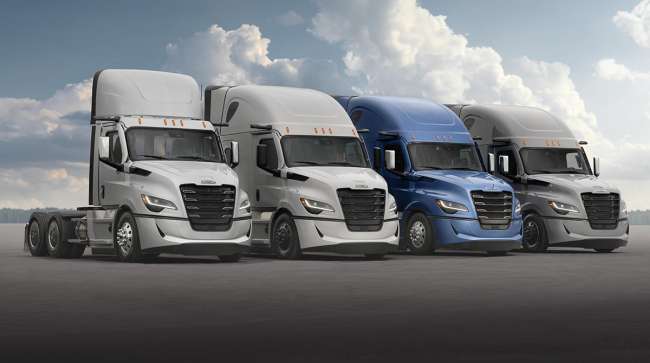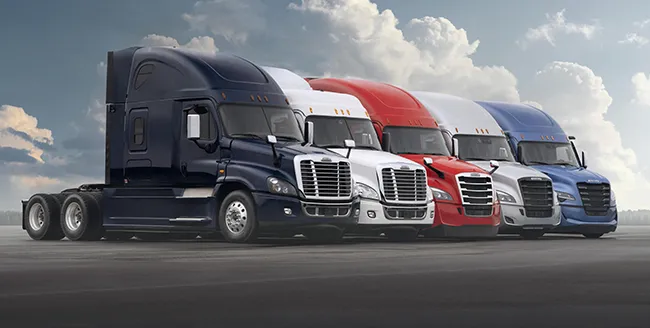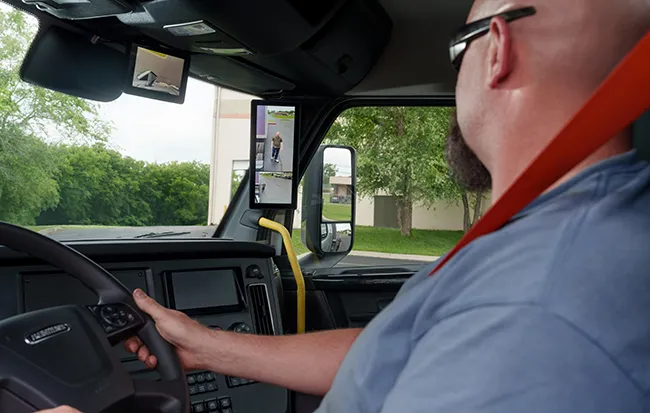Staff Reporter
Freightliner Launches Fifth-Generation Cascadia

[Stay on top of transportation news: Get TTNews in your inbox.]
Freightliner launched a fifth-generation Cascadia on Oct. 15 after publicly showcasing the Daimler Truck North America unit’s redesigned flagship Class 8 on-highway tractor for the first time at American Trucking Associations’ Management Conference & Exhibition.
DTNA’s order book for the latest iteration of the Cascadia is set to open later in 2024, Vice President, On-Highway Market Development Greg Treinen told reporters during a pre-launch event at the American Center for Mobility in Michigan.
Series production of the tractor — the first revamp in five years — is scheduled to begin in mid-2025, the company said.
Upon launch, engine options for the truck will be the Detroit DD13 and DD15 power plants, with ratings of up to 505 hp and 1,850 pound-feet of torque.
Cascadia Timeline
- 2007: Cascadia debuts, replacing the Century and Columbia models. Detroit Diesel DD15 engine platform introduced
- 2012: Second generation launches, introducing the Detroit DT12 automated transmission
- 2017: Third generation announced. Enhancements include reconfigured driver loft and greater connectivity
- 2019: Fourth generation brings SAE Level 2 capabilities, with automated software capable of both lateral (steering) and longitudinal (acceleration/deceleration) control
- 2022: Battery-electric version of its flagship model, the eCascadia, is unveiled at ACT Expo.
However, starting in 2026, the Cascadia will be available with Cummins’ X15 diesel and X15N natural gas engines, which will have 400 hp to 605 hp and 1,450 to 2,050 pound-feet of torque.
Those engines are located behind a revamped Cascadia grille, one of several changes immediately visible when encountering the tractor for the first time, including reconfigured headlights and updated A-pillar deflectors.
The dual-stage intelligent LED headlights offer a more aerodynamic profile, and DTNA says they can melt away ice and eliminate condensation in minutes.
“The innovation works in both warm and cold climates. If you’re in Alabama and you think, ‘What do I need deicing for?’ you actually need the defogging element,” Director of Marketing Communications Samantha Parlier told Transport Topics.
An updated A-pillar deflector that is longer and flares out on the bottom is intended to aid fuel efficiency, as are new bumper air ducts and an optional max aero bumper.
The bumper is replaceable and is larger, while also being more flexible, as customers said its predecessor was not durable enough, Parlier said.
“We never innovate just to innovate; it’s always for our customers,” General Manager, Product Strategy and Market Development Mary Aufdemberg told reporters, adding: “The truck is a thank you to our customers. A cheers to those who keep freight moving.”

All five generations of the Freightliner Cascadia together. (Daimler Truck North America)
“When we set out to develop this newest version and build on its legacy of excellence, we listened closely to our customers and what they, their drivers and their fleets needed. More safety features, greater efficiency and increased profitability is what we heard, and it’s what we’re proud to deliver,” said David Carson, DTNA senior vice president of sales and marketing.
Freightliner has been working with customers to get year-round feedback, Treinen added.
Heading up the safety enhancements are expanded capabilities for the Detroit Assurance system, including enhanced computing power and an upgraded camera, as well as four new short-range radar sensors and an improved long-range radar sensor.
As a result, Active Brake Assist 6 is now capable of braking automatically when vehicles are stationary in an irregular position, if approaching a vehicle on a curve, and can recognize both moving and stationary pedestrians; the latter for the first time.

Fifth-generation Freightliner Cascadia MirrorCam System enables easier spotting of pedestrians. (Daimler Truck North America)
Also, Active Lane Assist 2 adds lane change assist, which can provide steering in the opposite direction should a truck attempt to enter an already occupied lane.
If the situation gets even more dicey, when the lane keep assist feature is on and active, software monitoring driver attention through steering wheel input can begin to slow the truck to a stop and turn on the hazard lights if the driver is not responsive. This feature is seen as beneficial for drivers undergoing a medical emergency and their fellow road users.
The safety enhancements extend beyond these features, incorporating significant upgrades to the braking system.
Cascadia’s intelligent braking control system now offers brake-by-wire technology combined with backup pneumatics and employs wheel speed sensors and a chassis-mounted electronic control unit.
IBCS offers two new features:
- Comfort Braking — providing brake force distribution, lining wear control and performance monitoring
- Endurance Braking — blending the engine retarder and service brakes when the foot pedal is applied, helping to further extend brake life
In addition, an electronic park brake is on offer to mitigate the chances of a truck rolling away. The feature automatically applies the parking brake when a driver leaves the seat or opens the door without setting the brake.
Another cost-saving measure is the ability to remotely lock and unlock the vehicle on demand. Treinen said customers had been requesting the feature for some time as it will increase uptime because drivers will no longer need to call locksmiths and wait for them.
While the truck is moving, meanwhile, an evolution of the Side Guard Assist package to include the driver side of the truck is intended to aid drivers’ awareness of objects, as is the MirrorCam system, which is now factory installed.
The mirrors have hydrophobic coatings, which aid visibility in rainstorms as well as cleaning off dirt. MirrorCam is installed at the highest point possible, said Parlier. The feature is also equipped with infrared technology to help improve visibility at night and during inclement weather.
Want more news? Listen to today's daily briefing below or go here for more info:





